head FORD FIESTA 2007 Workshop Manual
[x] Cancel search | Manufacturer: FORD, Model Year: 2007, Model line: FIESTA, Model: FORD FIESTA 2007Pages: 1226, PDF Size: 61.26 MB
Page 776 of 1226
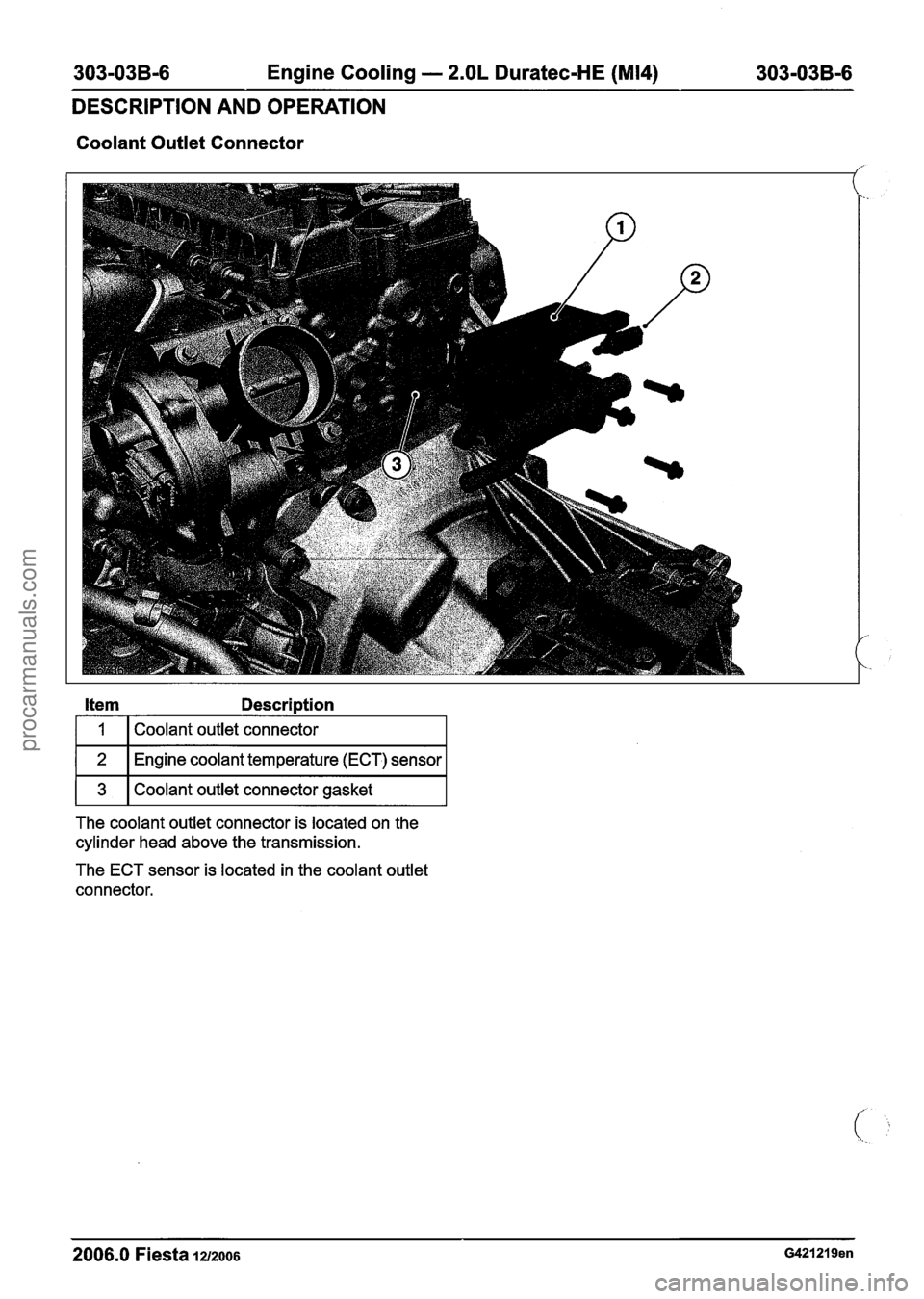
303-03B-6 Engine Cooling - 2.OL Duratec-HE (M14) 303-03B-6
DESCRIPTION AND OPERATION
Coolant Outlet Connector
I 1 I Coolant outlet connector I
1 2 1 Engine coolant temperature (ECT) sensor I
1 3 1 Coolant outlet connector gasket I
The coolant outlet connector is located on the
cylinder head above the transmission.
The ECT sensor is located in the coolant outlet
connector.
2006.0 Fiesta 1212006 G421219en
procarmanuals.com
Page 780 of 1226
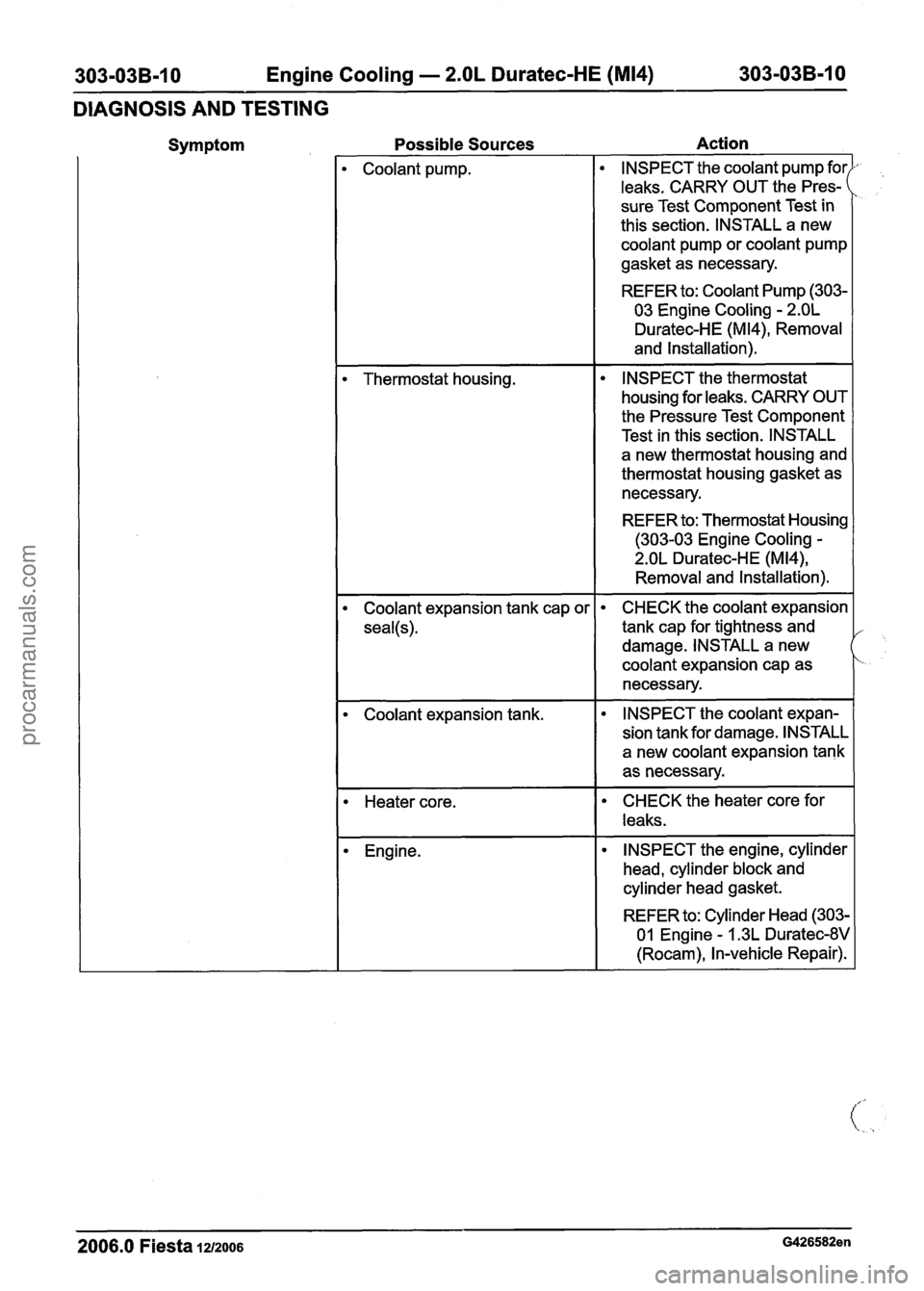
Engine Cooling - 2.OL Duratec-HE (M14)
DIAGNOSIS AND TESTING
Symptom Possible Sources Action
Coolant
pump.
Thermostat housing.
Coolant expansion tank cap or
seal(s).
- -
Coolant expansion tank.
Heater core.
Engine. INSPECT the
coolant pump
leaks. CARRY OUT the Pres-
sure Test Component Test in
this section. INSTALL a new
gasket as necessary.
REFER to: Coolant Pump (303-
03 Engine Cooling
- 2.OL
Duratec-HE (M14), Removal
and Installation).
INSPECT the thermostat
housing for leaks. CARRY OUT
the Pressure Test Component
Test in this section. INSTALL
a new thermostat housing and
thermostat housing gasket as
necessary.
REFER to: Thermostat Housing
(303-03 Engine Cooling
-
2.OL Duratec-HE (M14),
Removal and Installation).
CHECK the coolant expansion
tank cap for tightness and
damage. INSTALL a new
coolant expansion cap as
necessary.
INSPECT the coolant expan-
sion tank for damage. INSTALL
a new coolant expansion tank
as necessary.
CHECK the heater core for
leaks.
INSPECT the engine, cylinder
head, cylinder block and
cylinder head gasket.
REFER to: Cylinder Head (303-
01 Engine
- 1.3L Duratec-8V
(Rocam), In-vehicle Repair).
2006.0 Fiesta lu2006 G426582en
procarmanuals.com
Page 781 of 1226
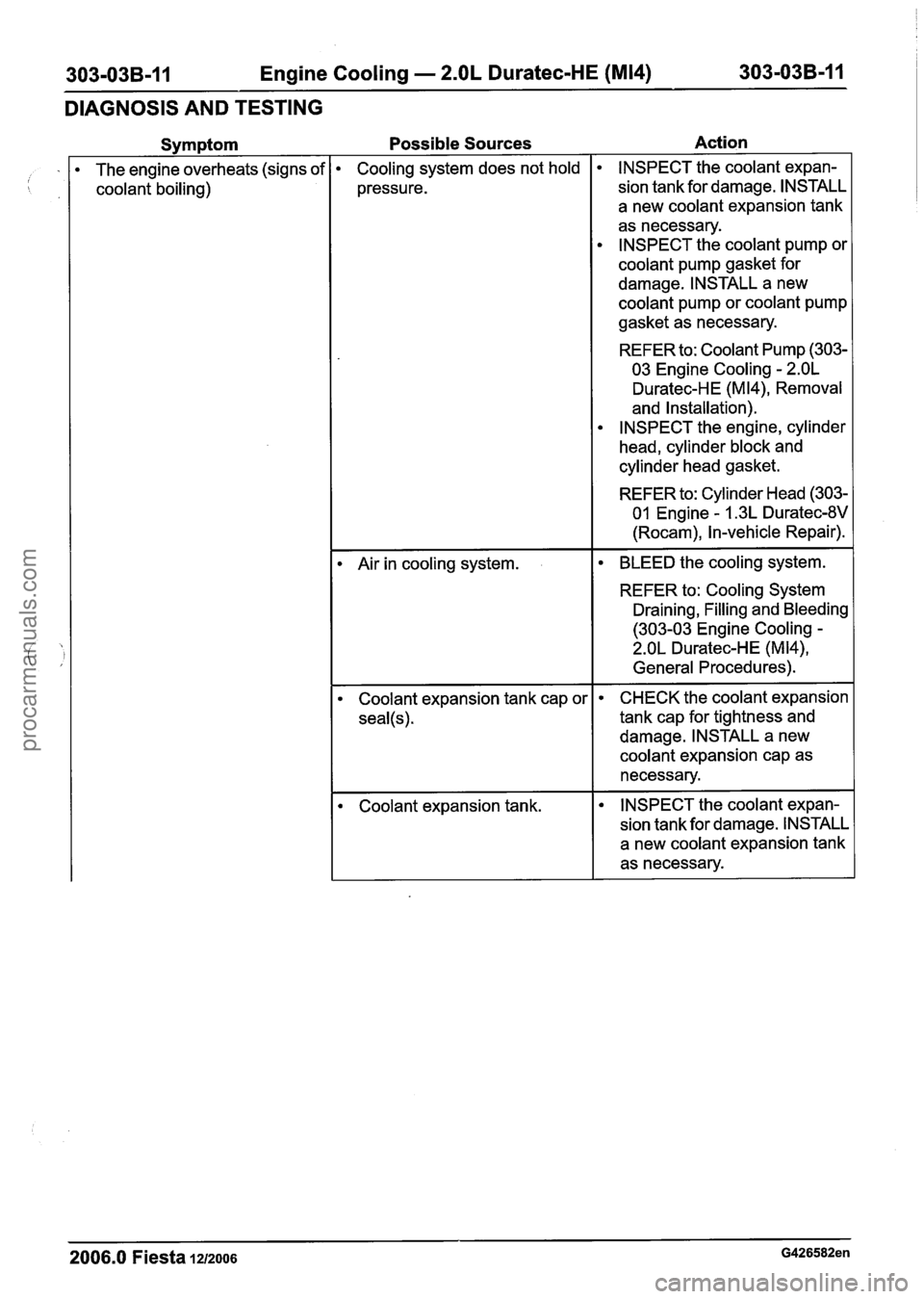
303-03B-11 Engine Cooling - 2.OL Duratec-HE (M14) 303-03B-1 I
DIAGNOSIS AND TESTING
Symptom
The engine overheats (signs of
coolant boiling)
Possible Sources Action
Cooling system does not hold
pressure. INSPECT
the coolant expan-
sion tank for damage. INSTALL
a new coolant expansion tank
as necessary. INSPECT the coolant pump or
coolant pump gasket for
damage. INSTALL a new
coolant pump or coolant pump
gasket as necessary.
REFER to: Coolant Pump (303-
03 Engine Cooling
- 2.OL
Duratec-HE (M14), Removal
and Installation).
INSPECT the engine, cylinder
head, cylinder block and
cylinder head gasket.
REFER to: Cylinder Head (303-
01 Engine - 1.3L Duratec-8V
(Rocam), In-vehicle Repair). -
Air in cooling system. BLEED the cooling system.
REFER to: Cooling System
Draining, Filling and Bleeding
(303-03 Engine Cooling
-
2.OL Duratec-HE (M14),
General Procedures).
Coolant expansion tank cap or
seal(s).
CHECK the coolant expansion
tank cap for tightness and damage. INSTALL a new
coolant expansion cap as
necessary.
Coolant expansion tank. INSPECT
the coolant expan-
sion tank for damage. INSTALL
a new coolant expansion tank
as necessary.
2006.0 Fiesta 1212006 G426582en
procarmanuals.com
Page 783 of 1226
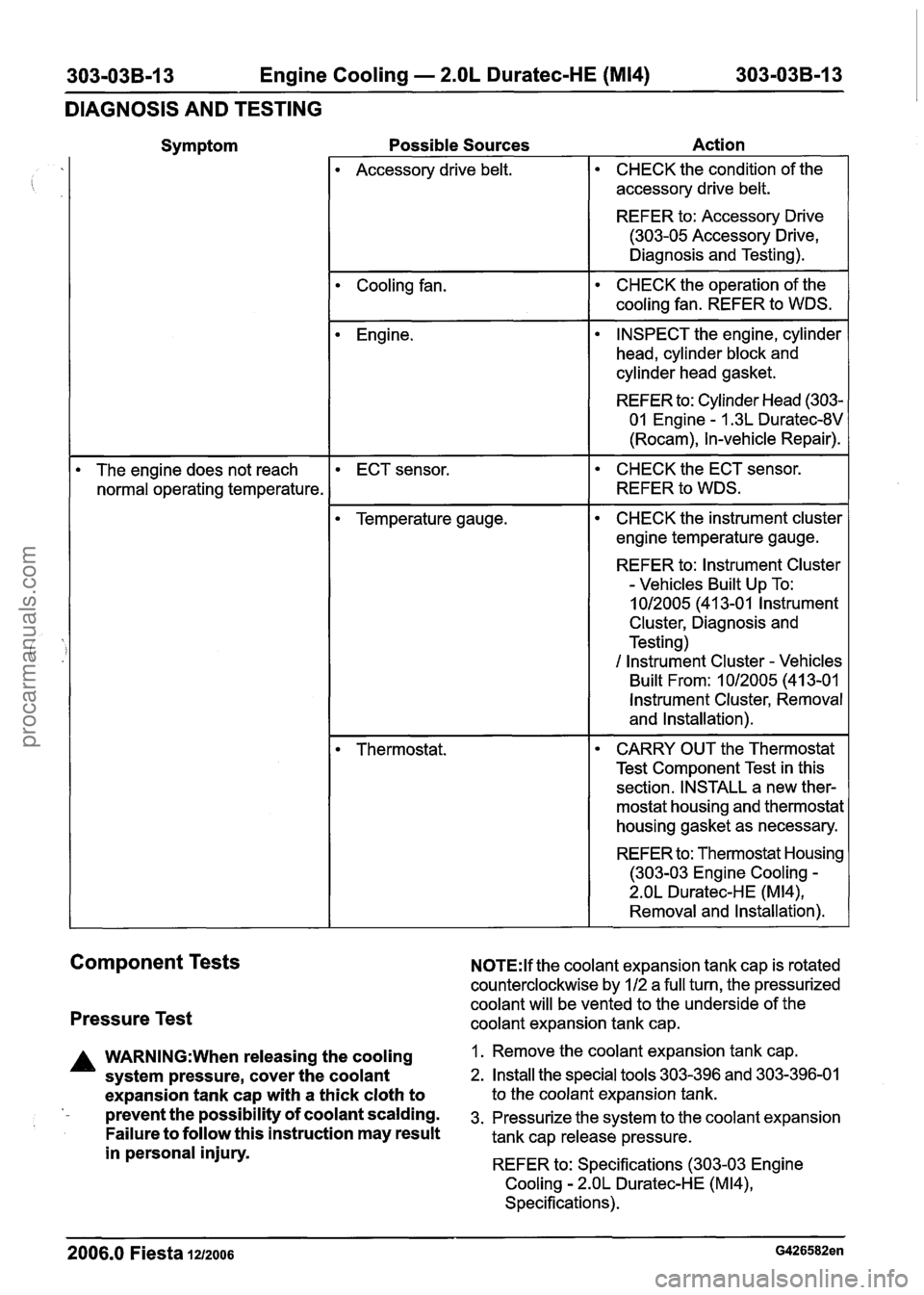
Engine Cooling - 2.OL Duratec-HE (M14)
DIAGNOSIS AND TESTING
Symptom Possible Sources
Action
I Accessory drive belt. CHECK the condition of the
accessory drive belt.
REFER to: Accessory Drive
(303-05 Accessory Drive,
Diagnosis and Testing).
Cooling fan.
CHECK the operation of the
I cooling fan. REFER to WDS.
Engine. INSPECT the engine, cylinder
head, cylinder block and
cylinder head gasket.
REFER to: Cylinder Head
(303-
01 Engine - I .3L Duratec-8V
(Rocam), I n-vehicle Repair).
The engine does not reach
normal operating temperature. CHECK the ECT sensor.
I REFER to WDS.
Temperature gauge. CHECK the instrument cluster
engine temperature gauge.
REFER to: lnstrument Cluster
- Vehicles Built Up To:
1012005 (41 3-01 lnstrument
Cluster, Diagnosis and
Testing)
I lnstrument Cluster - Vehicles
Built From:
1012005 (41 3-01
lnstrument Cluster, Removal
and Installation).
Thermostat. CARRY OUT the Thermostat
Test Component Test in this
section. INSTALL a new ther-
mostat housing and thermostat
housing gasket as necessary.
REFER to: Thermostat Housing (303-03 Engine Cooling
-
2.OL Duratec-HE (M14),
Removal and Installation).
Component Tests
Pressure Test
A WARNING:When releasing the cooling
system pressure, cover the coolant
expansion tank cap with a thick cloth to
- prevent the possibility of coolant scalding.
Failure to follow this instruction may result
in personal injury.
N0TE:lf the coolant expansion tank cap is rotated
counterclockwise by 1 12 a full turn, the pressurized
coolant will be vented to the underside of the
coolant expansion tank cap.
1. Remove the coolant expansion tank cap.
2. Install the special tools 303-396 and 303-396-01
to the coolant expansion tank.
3. Pressurize the system to the coolant expansion
tank cap release pressure.
REFER to: Specifications (303-03 Engine
Cooling
- 2.OL Duratec-HE (M14),
Specifications).
2006.0 Fiesta 1212006 G426582en
procarmanuals.com
Page 784 of 1226

303-03B-14 Engine Cooling - 2.OL Duratec-HE (M14) 303-03B-14
DIAGNOSIS AND TESTING
4. Observe the cooling system pressure tester make sure the pressure test reading
is
gauge reading for approximately two minutes. repeatable
and within acceptable gauge reading
The pressure should not drop during this time. limits of
the coolant expansion tank cap.
( If the system holds Pressure, proceed to Step 5. If the pressure test gauge readings are not 7. If the system does not hold pressure, check
within the acceptable gauge reading limits,
it thoroughly for coolant leaks.
INSTALL a new coolant expansion tank cap.
5. Check the engine for coolant leaks. Drain the
cooling system, repair any coolant leaks found
and fill and bleed the cooling system as
Thermostat Test
necessaw.
REFER to: Cooling System Draining, Filling and
Bleeding (303-03 Engine Cooling
- 2.OL
Duratec-HE (M14), General Procedures).
.Recheck the system by repeating Steps 3 and
4 at least twice.
Radiator Leak Test, Removed From Vehicle
CAUTI0N:Radiator internal pressure must
not exceed
130 kpa (20 psi) or damage may
result.
Clean the radiator thoroughly before leak testing
it, to prevent contamination of the water in the test
tank. Leak test the radiator in clean water with 138
kpa (20 psi) air pressure. Check it thoroughly for
air leaks. INSTALL a new radiator if necessary.
REFER to: Radiator (303-03 Engine Cooling
- 2.OL
Duratec-HE (M14), Removal and Installation).
Coolant Expansion Tank Cap Pressure Test
A WARNING:When releasing the system
pressure, cover the expansion tank cap
with a thick cloth to prevent the possibility
of coolant scalding, Failure to follow this
instruction may result in personal injury.
1. Remove the coolant expansion tank cap.
2. Use water to clean the area of the rubber seal
and pressure relief valve. Install the pressure
tester and adapter and immerse the coolant
-
expansion tank cap in water.
N0TE:lf the plunger of the pump is depressed too
quickly, an erroneous pressure reading will result.
3. Slowly depress the plunger of the pressure test
pump until the pressure gauge reading stops
increasing, and note the highest pressure
reading obtained.
4. Release pressure by turning the pressure relief
screw counterclockwise. Tighten the pressure
relief screw and repeat step 3 at least twice to
I. Connect the WDS to the data link connector
(DLC).
2. Using the WDS datalogger function, SELECT
the following sensors (as applicable to the
application):
IAT
- intake air temperature (IAT) sensor
ECT
- engine coolant temperature (ECT) sensor
CHT
- cylinder head temperature (CHT) sensor
LOAD
- engine load
VSS
- vehicle speed sensor (VSS)
RPM
- engine speed
DSRPM
- desired engine speed
The IAT sensor output is useful if the engine being
tested is cold or after an over-night cold soak. The
ECT sensor or CHT sensor and the IAT sensor
(
should either indicate the same value or be within
1 to 2 degrees Celsius of each other.
The ECT sensor output is important to display as
it indicates the engine warm-up and opening
temperature for the thermostat. It will initially
indicate a slightly higher reading just before the
thermostat opens and then drops back before
settling to a near flat line output (see graphic
below).
Item Description 1'. .
) A 1 Thermostat opens I\
B Thermostat settles into a cyclic open and
I I closure pattern
2006.0 Fiesta 1212006 G426582en
procarmanuals.com
Page 785 of 1226

303-03B-15 Engine Cooling - 2.OL Duratec-HE (M14) 303-03B-15
DIAGNOSIS AND TESTING
A CAUTI0N:lf the ECT sensor output reaches
the
120°C default line under normal cooling
system pressure, internal damage may be
caused to the engine and a diagnostic
trouble code (DTC) will be set in the PCM.
The test should be stopped and the cause
located and corrected. If the cooling
system does not pressurize, the coolant
will boil at
1 OO°C which may also damage
the engine. CARRY
OUT the Coolant
Expansion Tank Cap Pressure Test
Component Test in this section.
If the WDS only allows the ECT sensor to be
displayed in volts, refer to the following table for
corresponding Celsius values:
The CHT sensor output is useful to examine the
cylinder head temperature rise during the warm-up
cycle and later during the normal light throttle cruise
test. This sensor output may vary between vehicles
with manual transmission and vehicles with automatic transmission and should be used for
reference only.
Volts
1.33
1.02
0.78
0.60
0.46
0.35 0.27
The LOAD display is used for reference as it is
necessary to maintain a stable load line during the
test. It is necessary to carry out the test under
normal light throttle cruise driving conditions and
average loads, typically 40% to 70% of the load
value.
OCelsius
60
70
80
90
100
110
120 '
The VSS output is used for reference but can help
to identify misfires and sensors which fail during
the warm-up cycle.
The RPM display indicates the engine speed and
can be compared with the DSRPM.
The DSRPM is the desired or calculated idle speed
which the PCM commands the engine to reach. If
the thermostat opens too early (before the correct
opening temperature has been reached), the
engine will not reach this value. When
using the WDS in data logger mode, the
signals recorded should remain within the
DEFAULT values set by the WDS.
3m AWARNING:M~~~ sure that the WDS is
placed in the vehicle so that it does not
interfere with the safe operation of the
vehicle. Do not place the WDS in the
deployment path of any air bag. Failure to
follow these instructions may result in personal injury.
N0TE:The road test is best carried out with the
aid of another technician in the vehicle to enable
the vehicle to be driven safely while the sensor
outputs are monitored within datalogger. If there
is only one technician available, the WDS can be
set up (using the
recordlcapture mode camera
icon) before leaving the workshop to record a 16
km (1 0 mile) test.
N0TE:The results from the test are more
conclusive if the engine is cold when the test is
started.
Carry out a road test.
REFER to:
RoadIRoller Testing (1 00-00 General
Information, Description and Operation).
4. Drive the vehicle at a constant throttle opening
and set speed until the ECT value settles into
a shallow rise and fall signal, close to a straight
line. This indicates that the thermostat is
functioning correctly.
N0TE:Some thermostats indicate the
temperature(s) in Celsius and Fahrenheit.
The graphic below shows the location and an
example of the opening temperature
(88OC) and
fully open temperature (1
02OC) of a thermostat.
The graphic below shows an alternative method used to show the opening temperature
(88OC) and
fully open temperature
(112OC) of a thermostat.
2006.0 Fiesta 1212006 G426582en
procarmanuals.com
Page 791 of 1226
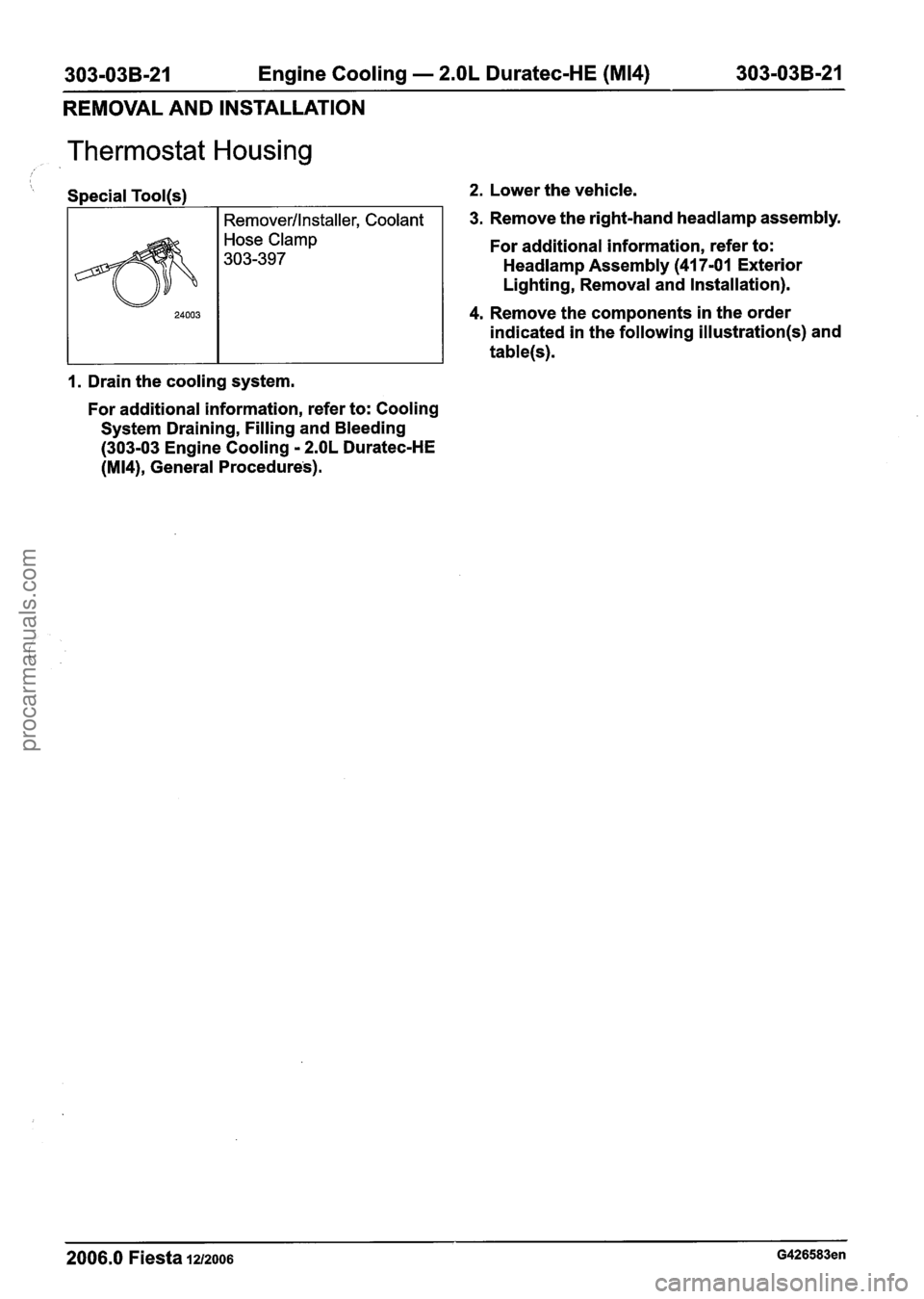
303-03B-21 Engine Cooling - 2.OL Duratec-HE (M14) 303-03B-21
REMOVAL AND INSTALLATION
Thermostat Housing
Special Tool(s) 2. Lower the vehicle.
I Remover/lnstaller, Coolant 1 3. Remove the right-hand headlamp assembly.
1. Drain the cooling system.
I
For additional information, refer to: Cooling
System Draining, Filling and Bleeding
(303-03 Engine Cooling
- 2.OL Duratec-HE
(M14), General Procedures).
Hose Clamp
303-397 For additional information, refer to:
Headlamp Assembly (41 7-01 Exterior
Lighting, Removal and Installation).
4. Remove the components in the order
indicated in the following
illustration(s) and
table(s).
2006.0 Fiesta 1212006 G426583en
procarmanuals.com
Page 813 of 1226
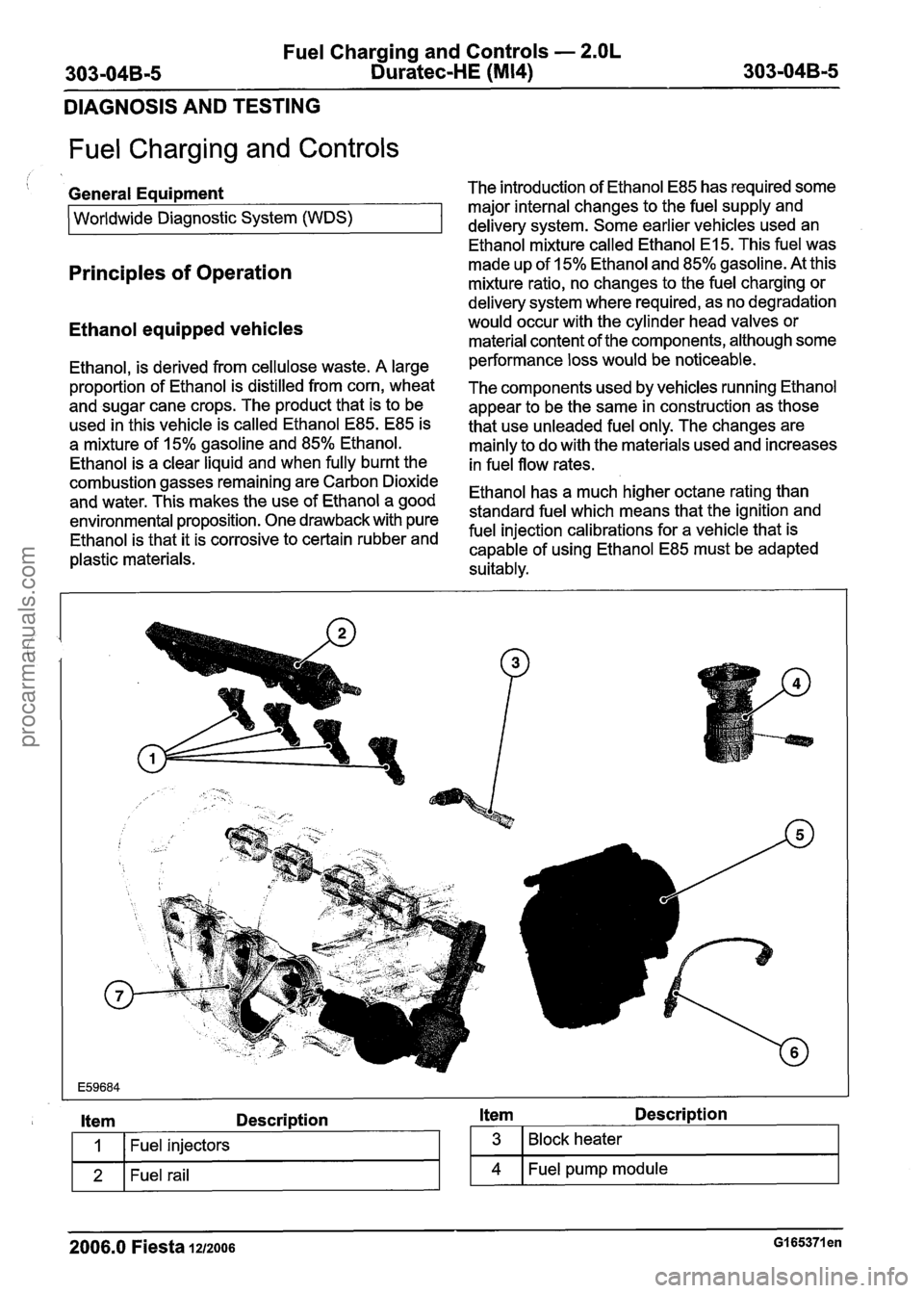
Fuel Charging and Controls - 2.OL
303-04B-5 Duratec-HE (M14) 303-04B-5
DIAGNOSIS AND TESTING
Fuel Charging and Controls
General Equipment
Wgnostic System (WDS) I
Principles of Operation
Ethanol equipped vehicles
Ethanol, is derived from cellulose waste. A large
proportion of Ethanol is distilled from corn, wheat
and sugar cane crops. The product that is to be
used in this vehicle is called Ethanol E85. E85 is
a mixture of 15% gasoline and 85% Ethanol.
Ethanol is a clear liquid and when fully burnt the
combustion gasses remaining are Carbon Dioxide
and water. This makes the use of Ethanol a good
environmental proposition. One drawback with pure
Ethanol is that it is corrosive to certain rubber and
plastic materials. The
introduction of Ethanol E85 has required some
major internal changes to the fuel supply and
delivery system. Some earlier vehicles used an
Ethanol mixture called Ethanol
El 5. This fuel was
made up of 15% Ethanol and 85% gasoline. At this
mixture ratio, no changes to the fuel charging or
delivery system where required, as no degradation
would occur with the cylinder head valves or
material content of the components, although some
performance loss would be noticeable.
The components used by vehicles running Ethanol
appear to be the same in construction as those
that use unleaded fuel only. The changes are
mainly to do with the materials used and increases
in fuel flow rates.
Ethanol has a much higher octane rating than
standard fuel which means that the ignition and
fuel injection calibrations for a vehicle that is
capable of using Ethanol E85 must be adapted
suitably.
I Item Description
I 1 I Fuel injectors
1ue1 rail I
2006.0 Fiesta 1212006 GI 65371 en
Item Description
3
4
Block heater
Fuel pump module
procarmanuals.com
Page 816 of 1226
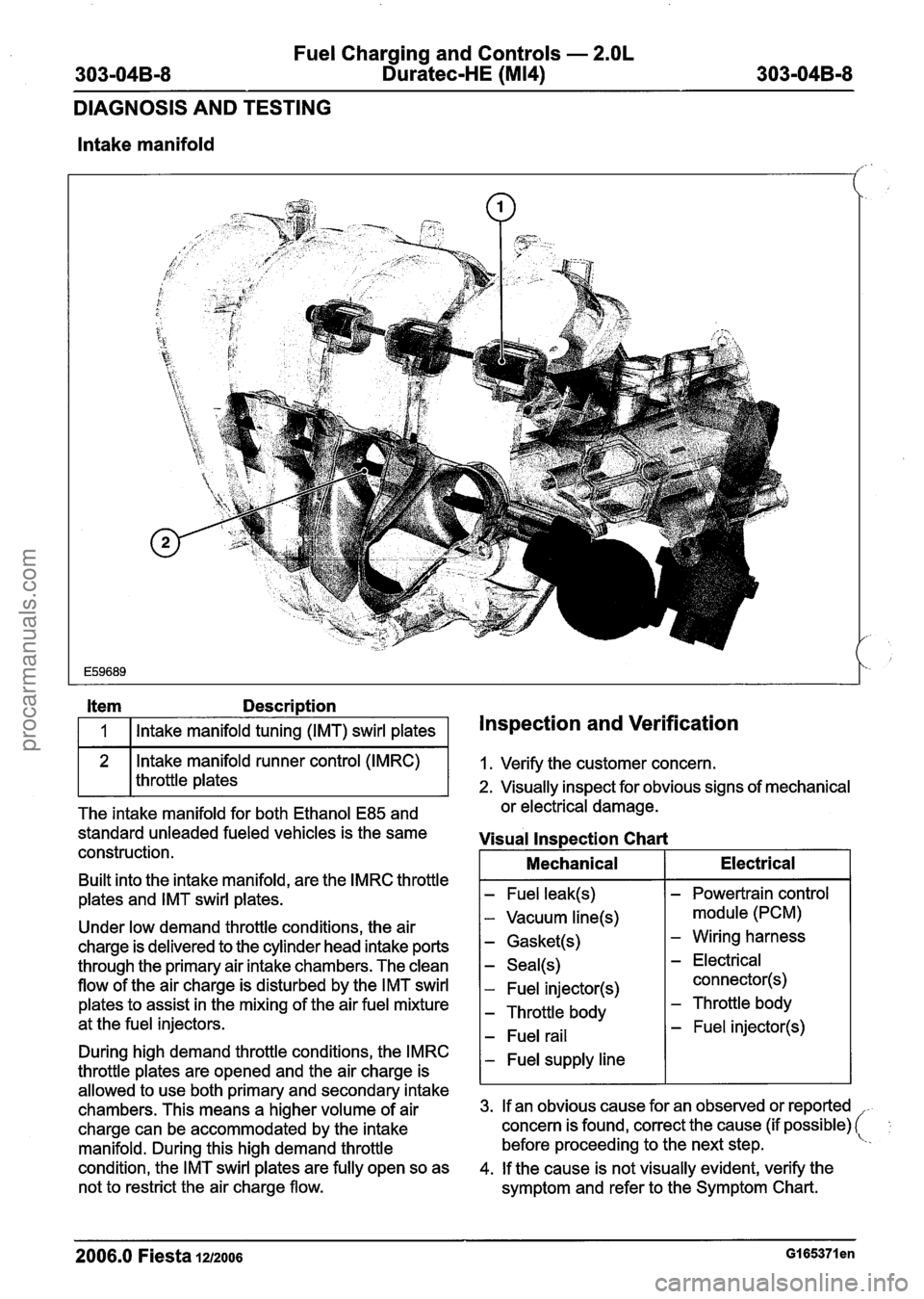
Fuel Charging and Controls - 2.OL
303-04B-8 Duratec-HE (M14) 303-04B-8
DIAGNOSIS AND TESTING
lntake manifold
item Description
I 1 I Intake manifold tuning (IMT) swirl plates I Inspection and Verification
121
lntake manifold runner control (IMRC)
throttle plates
The intake manifold for both Ethanol
E85 and
standard unleaded fueled vehicles is the same
construction.
Built into the intake manifold, are the
IMRC throttle
plates and IMT swirl plates.
Under low demand throttle conditions, the air
charge is delivered to the cylinder head intake ports
through the primary air intake chambers. The clean
flow of the air charge is disturbed by the IMT swirl
plates to assist in the mixing of the air fuel mixture
at the fuel injectors.
1. Verify the customer concern.
2. Visually inspect for obvious signs of mechanical
or electrical damage.
Visual lnspection Chart
I Mechanical I Electrical I
- Fuel leak(s)
- Vacuum line(s)
- Gasket(s)
- Seal(s)
- Fuel injector(s)
- Throttle body
- Fuel rail
- Powertrain control
module (PCM)
- Wiring harness
- Electrical
connector(s)
- Throttle body
- Fuel injector(s)
2006.0 Fiesta 1212006 GI 65371en
During high demand throttle conditions, the IMRC
throttle plates are opened and the air charge is - Fuel supply line
allowed to use both primary and secondary intake
chambers. This means a higher volume of air 3. If an obvious cause for an observed or reported
charge can be accommodated by the intake concern
is found, correct the cause (if
possible) (
before proceeding to the next step. \. . manifold. During this high demand throttle
condition, the IMT swirl plates are fully open so as
4. If the cause is not visually evident, verify the
not to restrict the air charge flow.
symptom and refer to the Symptom Chart.
procarmanuals.com
Page 826 of 1226
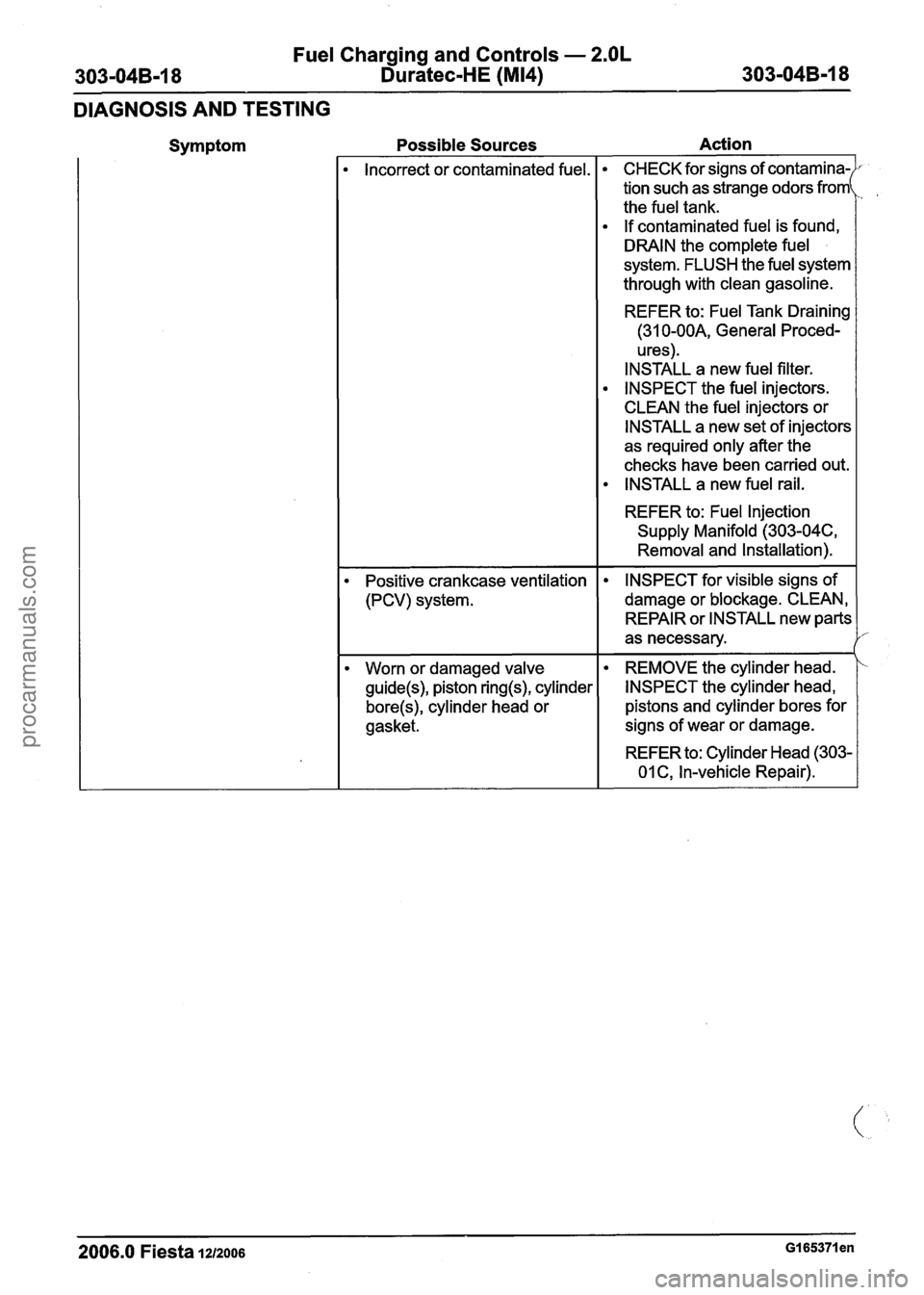
Fuel Charging and Controls - 2.OL
303-048-1 8 Duratec-HE (M14) 303-048-1 8
DIAGNOSIS AND TESTING
Symptom Possible Sources
Action -
lncorrector contaminated fuel. CHECK
for signs of
tion such as strange odors from
the fuel tank.
If contaminated fuel is found,
DRAIN the complete fuel
system. FLUSH the
through with clean gasoline.
REFER to: Fuel Tank Draining
(31
0-OOA, General Proced-
u res).
INSTALL a new fuel filter.
INSPECT the fuel injectors.
CLEAN the fuel injectors or
INSTALL a new set of injectors
as required only after the
checks have been carried out.
INSTALL a new fuel rail.
REFER to: Fuel Injection
Supply Manifold
(303-04C,
Removal and Installation). -- -
Positive crankcase ventilation
(PCV) system.
Worn or damaged valve
guide(s), piston ring(s), cylinder
bore(s), cylinder head or
gasket. INSPECT
for visible signs of
damage or blockage. CLEAN,
REPAIR or INSTALL new parts
as necessary.
REMOVE the cylinder head.
INSPECT the cylinder head,
pistons and cylinder bores for
signs of wear or damage.
REFER to: Cylinder Head (303-
01 C, In-vehicle Repair).
2006.0 Fiesta 1212006 GI 65371 en
procarmanuals.com